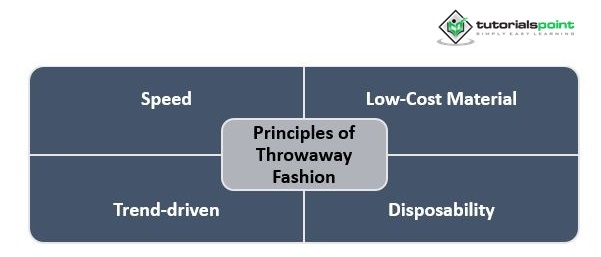

"Throwaway" or "fast fashion" refers to the trend of producing and selling clothing at a rapid pace, with styles changing quickly and low-cost materials being used. This results in frequent purchasing and disposing of clothes, contributing to environmental and ethical concerns. The concept has emerged as a response to the unsustainable and unethical practices in the fashion industry.

Throwaway fashion, also known as fast fashion, is a term used to describe the trend of producing and selling inexpensive, trendy clothing at a rapid pace. The focus is on quickly responding to the latest fashion trends rather than creating long-lasting, high-quality garments. This leads to an overproduction of clothing and a cycle of constant purchasing and disposing, which has negative impacts on both the environment and the workers in the fashion industry.
The concept of throwaway fashion is rooted in a focus on quantity over quality, with the goal of producing and selling large quantities of trendy clothing at low prices. The principles of this approach to fashion include the following
Speed − The production and sales cycle are accelerated, with new styles being introduced rapidly.
Low-Cost Materials − Clothing is made with inexpensive, low-quality materials to keep costs down.
Trend-driven − Styles are based on current fashion trends and change frequently to encourage customers to purchase new items.
Disposability − The short lifespan of the clothing and its low cost encourage consumers to dispose of it quickly and purchase new items.

The result of this approach is a constant flow of cheap, trend-focused clothing that contributes to environmental waste, labor exploitation, and a disregard for the long-term impact of fashion production and consumption.
The emergence of throwaway fashion can be traced back to the late 20th century and the rise of fast-fashion retail chains as a response to changes in the global economy and consumer culture. The rise of mass production and globalization made it possible to produce clothing quickly and cheaply, while the growth of consumer culture and the rise of fast-fashion retail chains created a demand for frequent, low-priced fashion updates. The fast-fashion business model was characterised by the rapid turnover of styles, low prices, and a focus on trends rather than quality or sustainability. The emergence of throwaway fashion can be attributed to a combination of economic, cultural, and technological factors, including

Globalization − The growth of global trade and the development of low-cost manufacturing in countries like China and Bangladesh made it possible to produce clothing quickly and cheaply on a mass scale.
Consumer Culture − The growth of consumer culture and the increasing importance placed on personal appearance and brand image have created a demand for frequent, low-priced fashion updates.
Retail Chains − Fast-fashion retail chains emerged to meet this demand, offering trendy, low-priced clothing that could be produced and sold quickly. Brands like Zara, H&M, and Forever 21 became leaders in this space, popularizing the fast-fashion business model.
Advancements in Technology − Advances in textile manufacturing and clothing production technologies allowed for the rapid and inexpensive production of clothing.
Marketing and Advertising − The fashion industry and retail chains heavily marketed and advertised their products, creating a culture of constant consumption and disposability.
These factors combined to create the conditions for the emergence of throwaway fashion, where the focus is on producing and selling large quantities of trendy, low-priced clothing at a fast pace rather than on creating high-quality, sustainable fashion. The result of these changes was a shift in the fashion industry towards producing high volumes of disposable clothing with a focus on trends, speed, and low prices rather than quality or sustainability. This led to the emergence of throwaway fashion as a concept and as a major contributor to environmental waste, labour exploitation, and unsustainable practices in the fashion industry.
The need for fast fashion emerged as a response to changes in consumer culture and the fashion industry. Retail companies saw an opportunity to meet the increasing demand for fashionable, low-priced clothing that could be produced and sold quickly. In an effort to keep up with upcoming changes and meet consumer demand, fast-fashion retail chains emerged, offering trendy, low-priced clothing that could be produced and sold quickly. This approach to fashion has since become a widely adopted business model in the industry. Additionally, fast fashion also emerged as a response to changes in the global economy, where companies were looking for ways to stay competitive and increase profits. The fast-fashion business model was attractive because it allowed companies to
Respond quickly to changing fashion trends − Fast-fashion companies could quickly produce and sell new styles based on the latest fashion trends, giving them an advantage over traditional fashion brands.
Keep prices low − The use of low-cost materials and mass production techniques allowed fast-fashion companies to keep prices low, making their products more accessible to a wider range of consumers.
Increase profits − The fast-fashion business model was designed to generate high volumes of sales and maximize profits. This was achieved by producing and selling large quantities of low-priced clothing and encouraging consumers to purchase new items frequently.
It was seen as a way for companies to meet consumer demand for low-priced, fashionable clothing and to stay competitive in a rapidly changing market.
In conclusion, throwaway fashion, also known as fast fashion, is a trend that emerged in response to changes in consumer culture and the fashion industry. The fast-fashion business model was designed to meet the growing demand for low-priced, fashionable clothing and to stay competitive in a rapidly changing market. The expansion of throwaway fashion was driven by globalization, the growth of consumer culture, advancements in technology, and the desire for companies to increase profits. However, this trend has had significant negative impacts on both the environment and workers, leading to increased scrutiny and calls for change in the fashion industry.